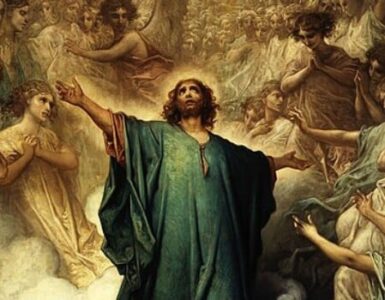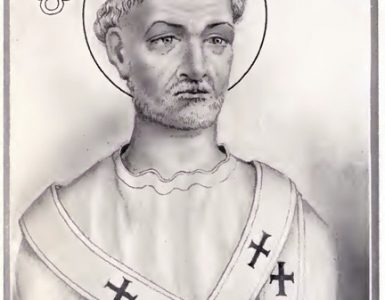Visitors to downtown Santa Fe are drawn to two majestic buildings, the Cathedral of St. Francis of Assisi and the Chapel of the Loretto Sisters. Little would one suspect today that the founder of these two buildings, the father of American Catholicism in the southwestern states of New Mexico and Arizona, was a Frenchman who came to America for the express intent of following the Great Commission, that command by Christ to “Go into the world and preach the gospel to the whole creation.”
When Jean Baptiste Lamy arrived at Santa Fe in 1851, the city was an old Spanish capitol, founded 242 years earlier. Only recently, at the end of the Mexican War, had the U.S. had taken control of the region politically and militarily. This shift also necessitated commensurate ecclesiastical changes.
The Vatican appointed the thirty-five-year-old Lamy Bishop Apostolic of the Diocese of New Mexico, a vast region of thousands of square miles encompassing the states of New Mexico, Arizona, western Texas, southern parts of Colorado and Nevada—in short, much of the borderland between Mexico and the United States. The land was sparsely settled; the farmers and ranchers harassed by aggressive Plains Native American tribes. The appointment was a surprise and an immense challenge for Lamy, who had only recently been a frontier parish priest in northern Kentucky and Ohio.
Lamy had been ordained in Montferrand. Recruited by Bishop Jean Purcell of Cincinnati, Lamy arrived in the United States in 1839. Twelve years later, he journeyed down the Ohio to the Mississippi River, on to New Orleans, from there to Galveston by steamer, followed by another sea journey to Matagorda Bay, then overland to San Antonio, eventually arriving at Santa Fe. He assumed control of a small town of mostly Mexicans served by a few priests who were basically on their own, since the Bishop of Durango, Mexico, was fifteen hundred miles away. The sacraments in Lamy’s new diocese were rarely administered and the morals of the priests were not befitting the heritage and magisterium of the Catholic Church.
Lamy discovered that he was to be a missionary bishop on horseback. He took to the road over and over, sometimes accompanied by soldiers, traders, or guides—sometimes alone, in a forbidding country of vast deserts, few settlements, and tribes discontented with the new authority of the United States.
One of his first journeys was to take his Vatican credentials and travel to and from Durango (three thousand miles), a six-month expedition, to apprise the bishop there of the change. In 1852, he journeyed to and from Baltimore to participate in a plenary council. On his return, he stopped in Kentucky and recruited sisters of the Loretto mission to hazard the journey to New Mexico to establish a convent.
Lamy made these harrowing exploits numerous times, often in the company of priests and nuns, and frequently experiencing attacks by the Apaches and other warlike tribes, such as the Pueblo, Comanche, and Navajo. In July, 1867, for example, he was escorting priests and sisters to Santa Fe when Plains Indians attacked. After a fierce battle, it’s recorded:
Sister Alphonsa Thompson, a native of Kentucky, fell sick. Night settling we camped, and she being very ill received the last Sacraments. The other sisters waited on her all night, and the next day we had to continue our journey. She was put into a wagon with four other sisters, and when we had halted, she died at ten o’clock, July 24, being not quite twenty years old.
(Quoted in M. Lilliana Owens, “Our Lady of Light Academy, Santa Fe,” New Mexico Historical Review 13 (1938))
Bishop Lamy realized that to reform the diocese’s declining morals, a consequence of ignorance, schools had to be built. The Loretto Sisters helped to fill the need, opening the school Our Lady of Light Academy in 1853. But the challenge of educating the poor and ignorant only grew over the years; in 1854, Lamy’s diocese expanded to include Colorado and the region of the Gadsden Purchase then acquired by the United States.
During the Civil War, to find priests to assist in the Arizona Territory, Father Lamy journeyed to California, crossing Death Valley and the Mohave Desert. Along the way, he chanced upon a settler who described the bishop as “a frank agreeable fascinating gentleman with the bonhomie of the Frenchman and the earnestness of the typical Christian. . . . A man of works rather than words, whose field of work is an empire, his diocese stretching from Denver to Mexico, from the Rio Grande to the Colorado” (Quoted in Paul Horgan, Lamy of Santa Fe, 1975).
Lamy sent his vicar general and close friend, Father Joseph Machebeuf, to Colorado to organize that region of his quickly growing diocese, centered in Denver. He frequently had to make the journey north into the Rocky Mountains, such as in 1866, when he made the nine-hundred-mile trip, founding churches and confirming neophytes to the Catholic faith. The next year, he journeyed to Rome to report to Pope Pius IX the 135,000 Catholics under his charge and the fifty-one priests he directed to serve them. Lamy became Archbishop in 1875, having spent twenty-four years in the desert southwest.
Recently, Pope Francis commemorated American missionaries in Puerto Rico, reminding us of our call to live out the Great Commission. Let us follow the example of Jean-Baptiste Lamy and dedicate ourselves to loving self-sacrifice in whatever way the Lord asks of us.
I end with a reflection from Willa Cather, who, in her fictional portrait of Lamy, Death Comes for the Archbishop, wrote of the total sacrifice of Lamy and the other American missionaries:
Those early missionaries threw themselves naked upon the hard heart of a country that was calculated to try the endurance of giants. They thirsted in its deserts, starved among its rocks, climbed up and down its terrible canyons on stone-bruised feet, broke long fasts by unclean and repugnant food. Surely these endured Hunger, Thirst, Cold, Nakedness, of a kind beyond any conception St. Paul and his brethren could have had. Whatever the early Christians suffered, it all happened in that safe little Mediterranean world, amid the old manners, the old landmarks. If they endured martyrdom, they died among their brethren, their relics were piously preserved, their names lived in the mouths of holy men. Riding with his Auvergnats to the old missions that had been scenes of martyrdom, the Bishop [Lamy] used to remind them that no man could know what triumphs of faith had happened there, where one white man met torture and death alone among so many infidels, or what visions and revelations God may have granted to soften that brutal end.
(Cather, New York: Random House, 1990)
Editor’s Note: This is the first article in a series on Catholic missionaries to North America.
Image from Audible












